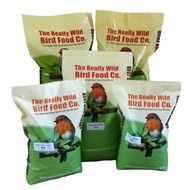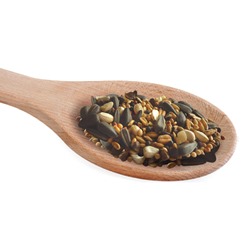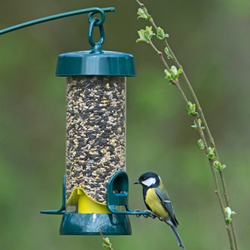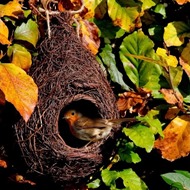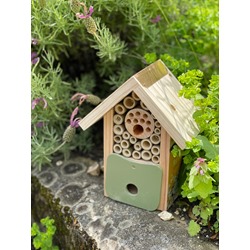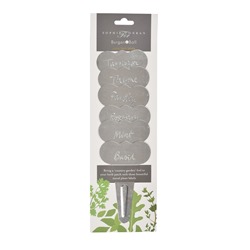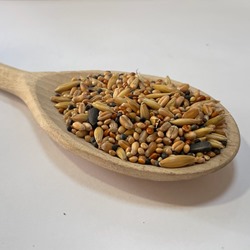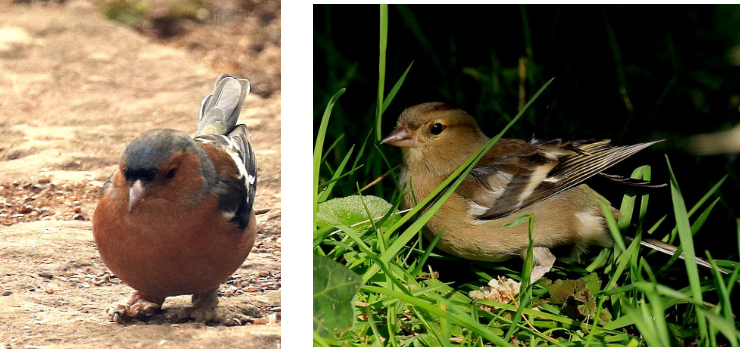
Papilloma viruses in chaffinches give rise to warty growths - which have colloquially been called "tassel foot", and I think you would agree, looking at the photographs which have been kindly sent to me by David White, it is a very good descriptor.
Papilloma viruses in humans cause skin warts, which are very common but usually resolve spontaneously. In fact, I remember as a child, my Dad 'buying my warts from me' for a 5p (or maybe it was a sixpence?) - and magically they used to vanish! I think he just got his timing about right.
However, much more seriously, a number of 'high risk' strains have been linked to cancers such as cervical cancer. However, papillomaviruses are very specific to their host species - so the good news is that infected birds pose no threat to us humans - nor to any other wildlife in the garden. The bad news is - that the virus can be easily transmitted from one bird to another - which is why you often see 'mini outbreaks' - where two or three birds are affected at any one time - or there is a lingering presence in the garden for a few weeks/months.
The virus is spread by direct contact and also through indirect contact via feeder perches, tree branches etc. It goes without saying, therefore, that if you do see an infected bird in the garden, make extra sure that you clean your feeders and feeding stations thoroughly - more advice on this is given here.
Of course please also wear gloves when disinfecting and don't clean feeders in areas where you prepare food!
Since feeding stations, bird tables and bird baths are where birds hang out, it may be prudent to put these areas out of commission for a couple of weeks. I know it feels like a tough thing to do, but dispersing the birds for a period will reduce the risk of spread, and hopefully will resolve the issue more quickly...... no one likes to see poorly birds. Having used the word 'poorly' it is also true that in many cases they are bright and seem to be totally unaffected- just sporting thick 'Nory Batty' legs! Very often they develop immunity and recover. Sometimes they become very lame and lose a toe and occasionally chaffinches will become very debilitated and die - however this is not the norm.
I hope you have found this summary helpful. Please do feel free to drop me a line if you would like some advice and I am always grateful for any good photographs that you might take - it helps me build my photographic library (because I am a good vet but a hopeless photographer!).
 Back
Back Bird Foods
Bird Foods
 Seed Mixes
Seed Mixes Straight Seeds
Straight Seeds Mealworms & Worms
Mealworms & Worms Chicken Feed
Chicken Feed Duck Food
Duck Food Peanuts & Peanut Butter
Peanuts & Peanut Butter Suet & Fat Balls
Suet & Fat Balls No Mess Bird Seed
No Mess Bird Seed Wheat Free Bird Seed
Wheat Free Bird Seed Sunflower Seeds
Sunflower Seeds Softbill Bird Food
Softbill Bird Food Bulk Bird Seed
Bulk Bird Seed Trial Packs
Trial Packs Pick & Mix
Pick & Mix Mini Pick & Mix
Mini Pick & Mix Birdie Basics: Budget Bird Food
Birdie Basics: Budget Bird Food Food for Small Birds
Food for Small Birds Back
Back Bird Feeders
Bird Feeders
 Seed Feeders
Seed Feeders Peanut Feeders
Peanut Feeders Peanut Butter Feeders
Peanut Butter Feeders Suet & Fat Feeders
Suet & Fat Feeders Window Feeders
Window Feeders Hanging Feeders
Hanging Feeders Feeding Stations
Feeding Stations Ground Feeders
Ground Feeders Easy Clean Feeders
Easy Clean Feeders Bird Tables
Bird Tables Seed Trays
Seed Trays Bird Baths & Drinkers
Bird Baths & Drinkers Feeder Accessories
Feeder Accessories Feeder Hygiene
Feeder Hygiene Squirrel Proof Bird Feeders
Squirrel Proof Bird Feeders For the Kids
For the Kids Niger Seed Feeders
Niger Seed Feeders Mealworm Feeders
Mealworm Feeders Bird Food Storage
Bird Food Storage Fat Ball Feeders
Fat Ball Feeders Tube Feeders
Tube Feeders



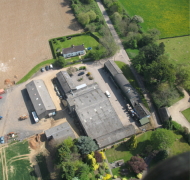 Our Farm
Our Farm
 Tips & Advice
Tips & Advice
Contact Us

